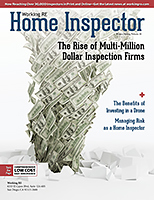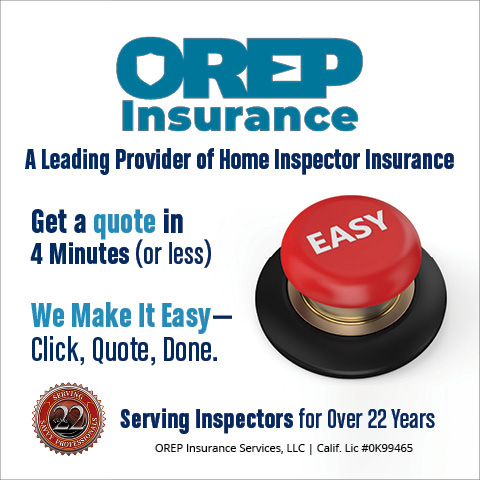 | > E&O/GL Insurance for Home Inspectors Competitive Rates, Broad Coverage, Free Risk Management, online inspection support for tough questions, discounts on education and more… Professional Coverage, Competitive Pricing Shop OREP today! |
Managing Risk as a Home Inspector
By Kendra Budd, Editor
There are a myriad of risks when it comes to your job as a home inspector. From slippery rooftops to rotting floorboards, a home inspector’s job is a hazardous one. However, one of the greatest risks any home inspector must be prepared to face is the wrath of their clients.
Most of the clients that home inspectors come in contact with are easy to work with, but there is always one that has to give you a run for your money. Whether your client found mold in the walls (which wasn’t visible, by the way!), or didn’t quite have their expectations of a home inspection met—well, sometimes they can get a little trigger-happy with the idea of bringing a claim against you. However, a great home inspector should always be ready for this possibility with every client.
There are many things you can do as a home inspector to protect yourself from claims, all the way from before the inspection to well after it. Here are just a few.
Before the Inspection
There are several steps you can take before your inspection to help mitigate risk—some of them are more obvious than others. These preemptive steps can greatly reduce the risk of potential claims against you, because you’ll be more than prepared for them.
- Marketing: You would be surprised just how many clients will use an inspector’s marketing against them. Marketing can be a great tool for getting more business, but when done improperly it can be detrimental. Let’s take taglines for example. A great witty tagline can make you stand out to prospective clients, but you have to make sure it’s not creating potential exposure for you.
An example of this would be using a tagline such as “No defect gets past us!” Although it’s eye-catching and memorable, it’s anything but the truth.
- Setting Realistic Expectations: Although it’s great to let your clients know everything you can and will do during an inspection, it’s just as important to let them know what you can’t do. For example, a home inspection is a visual non-invasive inspection, so you’re not opening up walls or taking things apart. Let your clients know what services you don’t cover too, such as mold or radon inspections, and be clear about it. Let your clients ask you questions before you begin, that way you’re all on the same page and there’s no confusion down the line.
- The Pre-Inspection Agreement: Every inspection you do should come with a thorough pre-inspection agreement. A pre-inspection agreement is a contract between you and your client outlining the services you will be covering. It especially lets your client know what your home inspection is not. This will serve as a great tool, especially if you and your client start to butt heads. You’ll be able to go back and remind them what they did and didn’t agree to.
However, you need to make sure that your pre-inspection agreement is thorough, conspicuous, and updated for each inspection. Some clients might try to look for loopholes otherwise—so it’s good to have all your ducks in a row. If you’re not sure what to include in your pre-inspection agreement read Key Clauses You Need in your Pre-Inspection Agreement on WorkingRE.com. Also, remember to always get the agreement signed before you do any sort of work as a signed pre-inspection agreement is a condition of coverage for most insurance policies.
- Insurance: Obtaining insurance before even doing your first home inspection seems like a no-brainer—however, you shouldn’t just be getting any insurance. OREP offers a complete package of E&O and General Liability Insurance Coverage for home inspectors. You want to ensure you have coverage for both. Many states require inspectors to only carry General Liability, but the majority of claims against home inspectors are E&O related.
(story continues below)
(story continues)
During the Inspection
Now comes the actual job, and what you do during the inspection could greatly decrease the risk of claims arising in the future. In fact, during the inspection, you should be taking pre-emptive steps just in case a client files a claim later on.
- Take Pictures/Videos: Part of your job is to take pictures, but during an inspection, there is no such thing as taking too many—the same can be said about videos. Get angles of everything you inspect. It pays to invest in a higher-quality camera and ensure that the pictures and videos are lit properly and clearly before moving on. These can later be used as evidence to help you against a claim.
- Create a Record: This goes beyond just the inspection report you create. Keep a thorough log of everything you encounter during your inspection. From a faulty roof to comments your client makes about the house, it’s important to keep everything in a dated log just in case you ever need to refer back to it. We’ve seen several instances where a home inspector notices something that needs to be called out, but forgets to write it down and it never makes it into the report.
- Invest in Signage: If your client is still going to be on the property while you’re inspecting your home, then it is a great idea to invest in signage. Let’s say that you’re inspecting a basement that has a hatch entrance, and you leave it open. If your client were to fall in and injure themselves, and you didn’t have signs as a warning, then you could be held liable.
After the Inspection
Finally, there are some steps you can take after the inspection to protect yourself.
- Keep Everything on File: A well-organized system can help you out greatly if a client were to make a claim against you. Remember all those pictures, videos, and detailed notes you took during the inspection? This is where they come into play. The human mind can only remember so much, but the information you gathered is forever. If a client makes a claim years later, your detailed report can serve as evidence.
- Inform Clients of the Severity of Problems: Once the inspection is complete, be honest with your client about any problems you found, and just how serious they are/can be. Let’s say you found slight damage to the roof and noticed that the tiles aren’t properly installed. Be upfront about anything that can and will go wrong if they don’t get it fixed. Make notes about this in your report too. Whether they choose to fix it is up to them, but you can sleep soundly knowing that you didn’t sugarcoat the severity.
- Never Admit Guilt: In the event of a client blaming you for something or bringing a claim against you, avoid admitting guilt or accepting fault—even if you think you should have caught the defect they are complaining about. Remember, your home inspection likely states that your inspection is not a guarantee that you can identify every defect and it is not a warranty against hidden defects. In some cases, an admission of guilt on your part to the client can affect your insurance coverage. This is where you want to promptly contact your insurance company and seek legal advice if necessary. (OREP provides its Members with attorney-led pre-claims assistance at no cost).
Final Thoughts
There’s no magic bullet that can guarantee you’ll never face a claim, but proactive measures can significantly mitigate your risk. Home inspections extend beyond the physical examination of a property; meticulous record-keeping, clear communication, and strategic planning are integral components of a home inspector’s risk management toolkit. Stay safe out there!
About the Author
Kendra Budd is the Editor of Working RE Magazine and Marketing Coordinator for OREP Insurance. She graduated with a BA in Theatre and English from Western Washington University, and with an MFA in Creative Writing from Full Sail University. She is currently based in Seattle, WA.
OREP Insurance Services, LLC. Calif. License #0K99465


